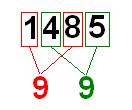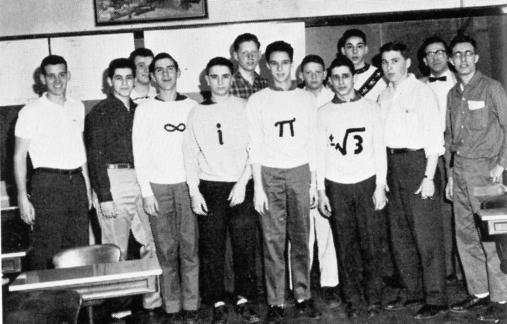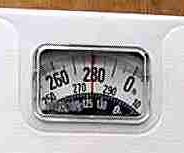
I've illustrated a sample scale reading in the picture to the left. For my metrically oriented readers, I should note that I didn't weigh 148.5 kilograms - I've never been obese. My American scale gave my weight in the English unit pounds, not in kilograms. Looking at my recorded weights one day, and being a mathematical kind of person, I happened to notice that, ignoring the decimal point, the sum of the numbers in the even digit positions and the sum of the numbers in the odd digit positions were the same. It's easier to draw a picture of this than to describe it in words. Using the numbers on the scale as seen above, consider:  Notice that the 1 and the 8 (in the odd positions from the left) sum to nine, and the 4 and the 5 (in the even positions from the left) also sum to nine. That would hardly have been remarkable if it only happened now and then. But in fact, it was the case for every single one of my recorded weights on the list for the previous few weeks. I looked back further on the list, and found a weight of 151.8. Obviously with that weight, the sum of the odd position digits is two, and the sum of the even position digits is 13. These sums are not the same, but rather differ by 11. Scanning back through the list of weights I had recorded, in every single case, the sum of the odd position digits either equaled the sum of the even position digits, or the two sums differed by precisely 11. Was there something special about the "11" days? Perhaps on those days I needed to consult my horoscope. Maybe those were dangerous days, when I needed to watch my step. This property of my weight seemed a little bit eerie. Have you figured out what was going on? You might want to pause here to think about it. Then scroll down for more.
Actually, I understood it right away. But then, I'm an electrical engineer. My entire career was dependent upon the existence of, and the properties of, the electron. But I've never seen one, and I never will, because they're smaller than a wavelength of light. Being an electrical engineer means that everything I deal with needs to be measured indirectly, by some instrument (I can't directly see either voltage or current). That means that in addition to understanding the properties of whatever is being measured, an engineer must understand the properties of the measuring instrument itself. And no measuring instrument is perfect. Each has its own resolution and accuracy (and by the way, resolution and accuracy are not the same thing). Each measurement may also be affected by noise or other confounding factors. An engineer has to understand the source of his or her information. Or as the comedian Emo Phillips once put it:
Alternatively, as the character Sportin' Life sang in Porgy and Bess, "It ain't necessarily so" (he was referring to the Bible). The idea that the actual weight of my body had this strange property is, of course, preposterous. What I was seeing had to be a property of the scale. Here's a thought experiment: imagine I am standing on that scale, and slowly picking up quarters to gradually increase my weight, starting from 148.5 pounds. What would the scale read as I picked up more and more coins? Would my indicated weight go up gradually, first to 148.6, then to 148.7, and so on? In fact, it wouldn't increase for a while, and when it did change, it would jump to 149.6. That's the next number for which the sum of the odd position digits and the sum of the even position digits are equal. Ignoring the decimal point, 1485 and 1496 are 11 apart. Hmmm, there's that 11 again. Is that a clue? Yes, it is. And here my thinking was helped by an experience from my past. In my senior year of high school, I was a member of a competitive mathematics team. We competed in a program called the "Nassau County Mathletes". Here's our team:  That's me in the front row, third from the right, wearing the sweatshirt showing ± the square root of three. The joke sweatshirts were sewn for the team by my mother, Rose Krakauer. Note 1 In our competitions, we would be given mathematical problems, and 5 minutes to come up with an answer. A favored sort of problem turned out to be what are called "divisibility problems". That is, solving them in a short amount of time involved quickly recognizing whether or not a number was evenly divisible by another number. In particular, we were once given a substantial list of numbers, and asked to determine how many of them were evenly divisible by 11. I didn't know how to do it at the time. But I know now, and shortly you will know too. Different numbers have different divisibility tricks. For example, a number is evenly divisible by three if and only if the sum of its digits is evenly divisible by three. That also works for nine, but for no other digit. It turns out that: In math-speak, the sum of its odd position digits and the sum of its even position digits are equal, "modulo 11". Thus, every single number the scale was giving me, if I ignored the decimal point, was some multiple of 11 (that is, was evenly divisible by 11). "Why 11?", I hear you cry. What a strange thing for the scale to do. Well, first of all, I've been ignoring the decimal point. In fact, the weights the scale was giving me were all multiples of 1.1 pounds. Does 1.1 pounds ring a bell? No? How about 2.2 pounds? 2.2 pounds is in fact the number of pounds in a kilogram. Although I've described the scale as an "American scale", if you flipped it over, it had a switch on the bottom. The two positions of the switch were labeled "pounds" and "kilograms". The resolution of each measurement was half a kilogram, or 1.1 pounds. With the switch in the "kilograms" position, each measurement ended in either .0 or .5, while in the "pounds" position, each measurement had to be a multiple of 1.1. Hence the observed property of the measurements. Note 2 Mystery solved. Here are some additional thoughts, which I thought would be disruptive as footnotes. I've noticed in the past that a great many talented automotive mechanics, who are whizzes at diagnosing mechanical problems, can be stymied by problems with a car's electrical system. I think that good mechanics have excellent "spatial relations", and are very good at picturing how mechanical parts move and interact. But sometimes people who are strong in that way have a harder time dealing with electricity, which you can't see. You have to infer what's going on by indirect measurement. Even scientists and engineers can forget themselves and become too trusting of their instruments. I recall a story about a graduate student giving a talk on some kind of subtle electronic effect. The well-known professor Harold "Doc" Edgerton happened to be in the audience, and he asked the speaker if the stray capacitance of the probe being used to make the measurement was distorting the effect. The graduate student basically said, "Oh - never mind", and sat down - a sort of Emily Litella moment. As for the divisibility-by-11 trick, you mathematicians might try proving it for yourself. I'd suggest an inductive proof - think about showing that if you add a 1 to one of the sums (odd position or even position digits), it always goes up by one more than the other sum modulo 11, even if one or more carries occurs. If a carry occurs, 1 is added to the other sum, but the sum carried from goes down by 9. And modulo 11, -9 is the same as +2. Example: 99999999 is evenly divisible by 11 (as is any integer with an even number of identical digits). Add 11, and you get 100000010, which is also evenly divisible by eleven. You can learn more about Divisibility in my later entry by that name.
  Note 1: The picture was scanned from the 1959 Arista, the Great Neck North High School yearbook. The other members of the team are identified under the photo as: Front row, left-to-right: E. Gruenstein, D. Levy, C. Bender, D. Bloch, R. Ott, L. Krakauer, K. Post, and R. Sylvan. Second row, left-to-right: R. Gruen, M. Schoenberg, P. Spiegelman, S. Einhorn, and the faculty adviser Mr. Isaacs. I wrote an article for the school newspaper to publicize the existence of the Mathletes. I mentioned that we wore numbered sweatshirts, like the athletes on any other team, although of course this was done as a joke. Carrying on in this light vein, I suggested that the team could use some cheerleaders, like our high school football team. Although I thought this was pretty clearly tongue-in-cheek, a girl in the school contacted me asking about the possibility of a cheerleader position. High school cheerleaders are always popular, of course, and perhaps she thought that if she couldn't get appointed a cheerleader for the football team, she could at least cheer the Mathletes. [return to text] Note 2: I have to confess that the scale shown in the picture at the start of this entry is not the scale I speak of in the text. I created that picture using my current scale. The older scale broke, and was discarded, long ago. Although you may be thinking back two weeks ago to my entry Piles, I am in fact capable of throwing things out. Sometimes. When the old scale died and I took it apart, I found it to be a pretty standard mechanical bathroom scale, modified to give a digital readout. That is to say, when you stepped on it, a mechanical linkage rotated a disk which was held back by a spring. The greater the weight on the scale, the further the disk rotated.
My digital version simply took away the window, and replaced that disk with one with black-and-white marks on it, whose passage was sensed by a photo transistor. You turned it on by pushing a button on the front with your toe. That set the scale to zero. You then stepped on it, and inside the scale, the disk rotated. The electronics counted how many marks rotated past the photo transistor. For each mark, it added 0.5 to the display if the switch was set to "kilograms", and 1.1 to the display if the switch was set to "pounds". [return to text]
 |
 This entry starts with a mystery, which is resolved by the end. When I diet, I generally weigh myself when I wake up each morning, and keep a running record of my weight. I'm not too concerned about changes from day to day, but it's nice to see an overall trend.
This entry starts with a mystery, which is resolved by the end. When I diet, I generally weigh myself when I wake up each morning, and keep a running record of my weight. I'm not too concerned about changes from day to day, but it's nice to see an overall trend.
 Analog scales using this mechanism simply had a window through which you could see the disk, with numbers showing your weight printed on the disk (like the one shown to the right).
Analog scales using this mechanism simply had a window through which you could see the disk, with numbers showing your weight printed on the disk (like the one shown to the right).